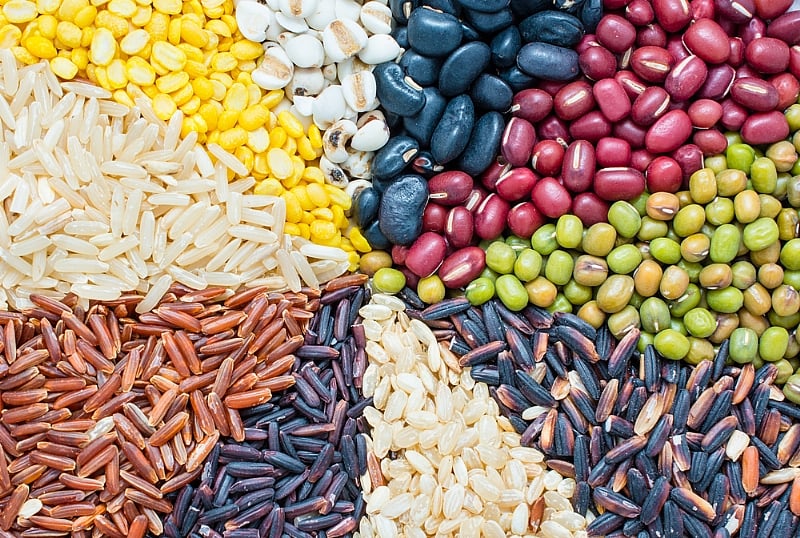Starch
Starch or amylum is a complex carbohydrate that exits in many foods including grains, vegetables and fruits. The principal sources of starch are; rice, maize, tapioca, cassava. The extraction of pure starch from food produces a white, tasteless and odorless powder that does not dissolve in cold water or alcohol.
Starchy foods are the main source of carbohydrate and play an important role in a healthy diet. They are also good source of energy and the main source of a range of nutrient in your diet. As well as starch, they contain fiber, calcium, iron and B vitamins. Essential part of a balanced diet, as they provide energy, fiber and a sense of fullness. The body breaks down starch molecules into glucose, which is the body’s primary fuel source. The brain, in particular requires a considerable amount of glucose each day.
Starch is natural polymer or polysaccharide, meaning that it is a long chain comprising one type of molecule. Starch consists of glucose molecules. It can occur in two form; amylose and amylopectin.
Amylose; is linear or straight line polymer that scientist describe as amorphous or solid.
Amylopectin; form a branched chain and is crystalline.
Different plants contain varying ratios of these polysaccharide units. However amylose general makes up a maximum of 30% of starch with the rest being amylopectin. Plaints create these starch polymers to store the glucose they create during photosynthesis. For this reason foods that are rich in starch are good sources of energy.
When someone eats food containing starch, the body breaks down the natural polymers into units of glucose, which provide energy throughout the body. Being beside part of a nutritious diet various industries including pharmaceutical, paper, and food use starch in their manufacturing processes.
Types
A nutritional characteristic of starch fits into one of the three groups;
Rapidly digestible starch (RDS); this form of starch exists in cooked foods such as potatoes and bread. The body rapidly converts it to glucose.
Slowly digestible starch (SRS); this starch has a complex structure, meaning that the body breaks it down slowly. It exits in cereal grains.
Resistant starch (RS); the body cannot easily digest this form of starch, and it can pass through the digestive system untouched, similar to dietary fiber. It may support healthy intestine micro-flora.
Dr. Adrienne Seitz MS, RD, LDN medically reviewed further divide resistant starch RS into four categories including;
RS1; which exits in grain, seeds and beans
RS2; from raw potatoes and unripe bananas
RS3; from foods that undergo cooking then cooling such as rice and cornflakes.
RS4; which is in bread.
She says modified starch which is a starch derivative that manufactures had treated to change its properties. The baking industry widely uses this form of starch because it can tolerate a range of conditions, including extreme heat or cold.
Rice (Grain) consumption in Ghana
Rice has significant nutritional value, high carbohydrates, low fat and rich in minerals, vitamins and protein (El mowa et al 2021). Trace elements, Thiamin and niacin and minerals, such as zinc and phosphorus.
In 2022 Ghana imported $318 million in rice became the 29th largest importer of rice in the world. At the same year rice was the 4th imported product in Ghana. Ghana imported rice primarily from Vietnam ($230M), India ($30M), Thailand (24.7M), China ($11.2M) and Cote d’ivoire ($10.6M).
Rice imports in Ghana fell about 45% to 34% between 2021 and 2023 data from Ministry of Food and Agriculture has revealed. In 2021 the totally rice imported was estimated at 805,000 metric tons, it fell to 650,000 metric tons and subsequently to 440,000 metric tons in 2023.
Ghana domestic rice production (paddy) increased from 463,000 metric tons in 2011 to 119,000,000 metric tons in 2022 by Ministry of Food and Agriculture. The per capital rice consumption is above 52kg per person, per year. Such as Ghana made Nana’s Rice.
Recommendation
Risk and side effects for most individuals starch does not present any risk or side effects. Dr.Osborn Boatang specializes in internal medicine Manhyia District Hospital Kumasi says; that people should eat a balance diet that includes starchy foods. Individual with type 1 diabetes count how many grams of carbohydrates they should eat, and then balance with their insulin dose. Individual with type 2 should avoid consuming quantities of carbohydrates in one sitting and spread them evenly throughout the day instead.
BY MUSTAPHA BATURE SALLAMA
MEDICAL/SCIENCE COMMUNICATOR
+233-555-275-880
[email protected]


